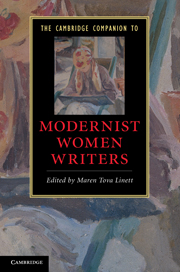Book contents
- Frontmatter
- Modernist women’s literature: an introduction
- 1 Transforming the novel
- 2 Modernist women poets and the problem of form
- 3 Women’s modernism and performance
- 4 Magazines, presses, and salons in women’s modernism
- 5 Gender in women’s modernism
- 6 Black women’s modernist literature
- 7 Race and ethnicity in white women’s modernist literature
- 8 Geomodernism, postcoloniality, and women’s writing
- 9 Women modernists and visual culture
- 10 Modernism and trauma
- 11 Political activism and women’s modernism
- 12 Religion and the occult in women’s modernism
- Guide to further reading
- Index
3 - Women’s modernism and performance
Published online by Cambridge University Press: 28 November 2010
- Frontmatter
- Modernist women’s literature: an introduction
- 1 Transforming the novel
- 2 Modernist women poets and the problem of form
- 3 Women’s modernism and performance
- 4 Magazines, presses, and salons in women’s modernism
- 5 Gender in women’s modernism
- 6 Black women’s modernist literature
- 7 Race and ethnicity in white women’s modernist literature
- 8 Geomodernism, postcoloniality, and women’s writing
- 9 Women modernists and visual culture
- 10 Modernism and trauma
- 11 Political activism and women’s modernism
- 12 Religion and the occult in women’s modernism
- Guide to further reading
- Index
Summary
As a young journalist in New York in 1914, Djuna Barnes voluntarily underwent forcible feeding in order to write about the involuntary experiences of hunger-striking British suffragists. In “How It Feels to Be Forcibly Fed,” she recalls being bound to the operating table and held down at the head, hips, and feet by three men while the doctor inserted the feeding apparatus through her nose; and although she states that “it is utterly impossible to describe the anguish” of the experience, she proceeds to describe it with extraordinary vividness and power: “If I, playacting, felt my being burning with revolt at this brutal usurpation of my own functions, how they who actually suffered the ordeal in its acutest horror must have flamed at the violation of the sanctuaries of their spirits. I saw in my hysteria a vision of a hundred women in grim prison hospitals, bound and shrouded on tables just like this, held in the rough grip of callous warders while white-robed doctors thrust rubber tubing into the delicate interstices of their nostrils and forced into their helpless bodies the crude fuel to sustain the life they longed to sacrifice.” In summing up her experience, Barnes observes, “For me it was an experiment. It was only tragic in my imagination. But it offered sensations sufficiently poignant to compel comprehension of certain of the day's phenomena.”
- Type
- Chapter
- Information
- The Cambridge Companion to Modernist Women Writers , pp. 47 - 61Publisher: Cambridge University PressPrint publication year: 2010
- 1
- Cited by

